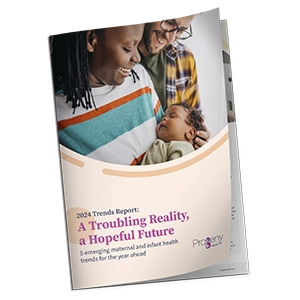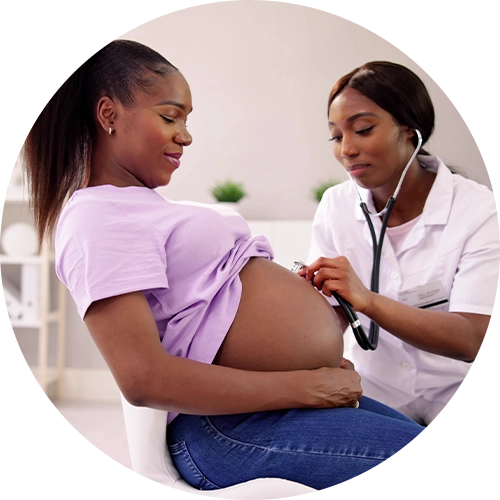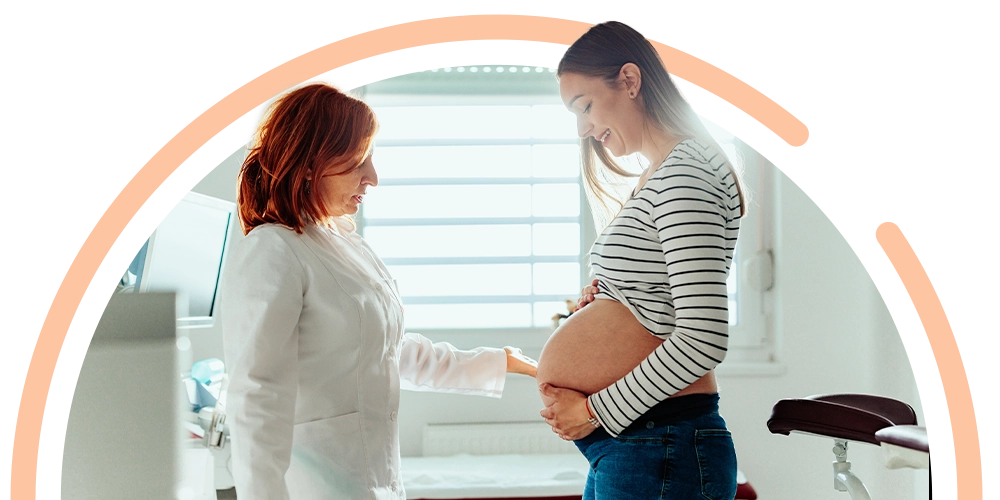2024 Trends Report: A Troubling Reality, a Hopeful Future
10-minute read
Five emerging maternal and infant health trends and how they will impact the year ahead.
Maternal health is in a state of crisis across the United States. Maternal mortality is rising, perinatal mental health conditions are going untreated, and social determinants are increasing maternal distress. Worst of all, spiking rates of preterm birth mean one in ten babies are born early.
For health plans, reducing risk is key. Learn how the industry is stepping up to address five emerging trends that indicate a hopeful future for maternal health.
Start Reading


Introduction
Doubling Down on Risk Reduction:
The perilous state of maternal and infant health is evident, and healthcare stakeholders are stepping up to change it.
In recent years, it’s been impossible to miss the recurring drumbeat that maternal health is in a state of crisis across the United States. The figures, now familiar, continue to be sobering: Maternal mortality has been steadily rising, doubling between 1999 and 2019, a JAMA study found. In 2019, the rate of maternal mortality was 20.1 deaths per 100,000 live births, a figure that increased to 23.8 in 2020 and leapt to 32.9 in 2021, the Centers for Disease Control and Prevention (CDC) reports.
Data from 2022 and 2023 show a promising dip in these figures, but the fact remains that the U.S. has the highest maternal death rate of the world’s wealthiest nations. Staggeringly, women today are 50% more likely to die in childbirth than their mothers were. Worse, as many as 80% of these pregnancy-related deaths are preventable. Nearly a quarter of pregnancy-related deaths are the result of mental health conditions, including suicide and overdose. Perinatal mood and anxiety disorders now affect as many as one in five mothers in the U.S., and that figure is double for Black women.
Pregnancy-related mortality impacts American populations differently. Stark disparities continue to persist: Black women and American Indian and Alaska Native (AIAN) women are three and two times more likely, respectively, than white women to die of pregnancy-related causes. In addition, infants born to Black, AIAN, and Native Hawaiian and Other Pacific Islander (NHOPI) women have far higher mortality rates than those of white women—even despite the overall reduction in infant deaths in the past decade. Maternal and infant mortality, however, are not the only measures of an ailing system. Rates of preterm birth have also steadily risen, spiking in 2022 when 1 in 10 babies were born at least three weeks early. Despite this statistic gaining widespread national attention, the alarming rate of preterm births fell by only 1% in 2023.
50%
Of women today are more likely to die in childbirth than in previous generations
3x
Higher pregnancy-related mortality rates for Black women compared to White women
10%
Of newborns were preterm by at least 3 weeks in 2022
What is causing this distressing situation? A complex mix of factors that are often more sociological than biological. People’s experiences and social circumstances—Social Determinants of Health (SDoH) such as education level, income, geography, and race—have been shown to influence 80 to 90% of their health status. Although first coined in 1992, the term “weathering”—the cumulative physical effects of racism on an individual—has only recently become more widely integrated into the public health lexicon.
~90%
Of health outcomes are influenced by SDoH
Focusing on SDoH to uncover risks is far from new, but payers and providers are looking at these guidelines more closely to determine if they truly capture the realities of today’s maternal and infant health landscape. Those realities include systemic bias in the healthcare system, maternal health care deserts, lack of health insurance, and the difficulties women face in taking time off from work to attend numerous prenatal appointments.
Amid this deeply concerning state of affairs, healthcare industry stakeholders are continuing to find new and innovative ways to turn the tide of maternal health in America. This includes making it easier for women to access healthcare and for providers to quantify pregnancy risk factors.
In the year to come, even more attention and action will be directed at making women’s health and healthcare more accessible, equitable, and critical. And technology such as artificial intelligence (AI) will play a key role in making that happen. In the pages that follow, we outline some of the top trends coalescing around the improved safety of women and their babies.

Trend #1
Stronger Health Plan Interventions:
Payers are expanding efforts to improve maternal and infant health outcomes and equity.
Stakeholders in the healthcare industry are eager to stem the tide of poor health outcomes and diminished equity in maternal and infant health. Payers and providers are especially focused on the powerful potential of removing barriers to healthcare—prenatal healthcare in particular. Here’s one major reason why: when pregnant individuals don’t receive prenatal care, their infants are five times more likely to die during birth or the postpartum period.
To better ensure that pregnant members receive the care they need, payers are considering providers’ push for fewer in-person prenatal visits, but more rigorous at-home monitoring. That proposal is based on research showing that nearly two-thirds of pregnant patients would prefer fewer treks to the OB, and that fewer prenatal visits for low-risk pregnancies doesn’t equate to worse outcomes. Just the opposite in fact.
What does this model of care look like? It might involve at-home weight, blood pressure, and fetal heart monitoring, as well as frequent phone-based check-ins with nurses or doctors over the course of the pregnancy.
A host of providers have been advocating for this stay-at-home-but-stay-in-touch model of prenatal care for some time—but it’s incumbent upon payers to pave the way for patients to make use of it. Currently, only 19 state Medicaid programs reimburse for telemedicine services—a figure that will need to change before this model of prenatal care can be rolled out more widely.
5x
Higher infant-mortality rate for newborns whose mother didn’t receive prenatal care
19
State Medicaid programs reimburse for telemedicine services
Payers are also zeroing in on new thinking around the postpartum period as well. That’s spurred in part by the government mandate that Medicaid programs seek solutions to the maternal mortality crisis. Many states have extended Medicaid coverage for up to a full year after birth, and commercial plans are taking notice—and devising their own solutions to the maternal and infant health emergency; one that includes the estimated 10% of women who develop postpartum anxiety and the 20% who develop postpartum depression.
10%
of women develop postpartum anxiety
20%
of women develop postpartum depression
The standard of care in the U.S. includes only one checkup at the six-week postpartum mark, which has been determined to be insufficient. Focus is shifting to postpartum support coming in tandem with the new understanding that this period is not only a newborn coming into the world, but also a transitional period for the birthing individual.
These conditions can have profound effects on mothers, their infants, and families, including disrupted sleep and withdrawal from social situations. Women not only need to be screened for these conditions, but also must have access to health insurance to pay for the mental health services they need for treatment.
Payers taking action:
Many healthcare plans are taking steps to ensure that women can access the maternal healthcare they need.
- Aetna Better Health of Florida has spearheaded an initiative to impact the nation’s increasingly high rate of c-section births, which is associated with a higher infant mortality rate. The organization’s strategy involves better educating providers about what constitutes quality criteria for a c-section, assigning obstetrical nurses to high-risk cases so they can coordinate care with the patient’s OB or perinatologist, and providing no-cost coverage for pre- and postpartum doulas. Additionally, Aetna Better Health of Florida has partnered with ProgenyHealth to deliver an integrated Maternity & NICU Care Management program for its members. Timely identification and ongoing education via an app, support for all risk levels –including dedicated case management — from pregnancy through 12 months postpartum, and support for a wide range of social and behavioral challenges are all helping to improve maternal and infant health outcomes.
- Western Sky Community Care of New Mexico provides patients with access to a network of doulas whose services are available via 24/7 digital appointments. The doulas can assist patients with everything from crafting a birth plan to finding resources for postpartum mental health concerns.
- Health Care Service Corporation (HCSC) an Independent Licensee of the Blue Cross and Blue Shield Association, has made a concerted effort to focus on supporting moms and babies through a Centering Pregnancy program, and improving access to care through expanded coverage. For example, mobile health programs in Illinois, Montana, New Mexico, Oklahoma and Texas collaborate with community partners to deliver immunizations and other important health services and information where people live, work, shop and go to school.
- Community Health Choice in Houston, Texas is tackling one of the nation’s most troubling health disparities: Harris County ranks third, behind only Chicago’s Cook County and Detroit’s Wayne County, in what are known as excessive Black infant deaths, according to the federal Health Resources and Services Administration. Community Health Choice is taking a multi-pronged approach to tackle this crisis, including robust maternity care management, provider programs such as Accountable Care Organizations and other value-based care programs with prenatal and postpartum quality measure incentives, and community collaboration efforts. On the care management front, the health plan is emphasizing early pregnancy detection by leveraging the ProgenyHealth app, which allows women to self-enroll in maternity care management at the earliest stages of their pregnancies. To date, nearly 15% of enrollments into the program come through this “digital front door.”
Medicaid Expansion
Gives coverage to all people in a state whose income falls beneath a certain threshold. States that have expanded Medicaid see seven fewer maternal deaths per 100,000 live births when compared to states that haven’t. These states have also experienced a decrease in infant deaths.
Addressing Common Pregnancy Challenges that Payers Face
Several stumbling blocks account for many problematic—and even tragic—pregnancies and births. ProgenyHealth is partnering with payers and providers to take on each one.

Delayed Intervention
The earlier a pregnant woman can begin prenatal care, the better the odds of a positive outcome for both parent and child. Yet, too often this is not the case. A 2020 report from BlueCross BlueShield found that 14% of women did not receive prenatal care within the first trimester, with nearly half citing SDoH issues, including barriers to scheduling and transportation. What’s more, an increasing number of women are entering pregnancy with pre-existing conditions. Through the use of ProgenyHealth’s digital app and support, more pregnancies can be identified sooner, allowing for earlier interventions.

Drop-offs in Provider Contact
Research shows that many pregnant women are unable to attend all of their prenatal appointments, and ultimately many wind up losing contact with the healthcare system. ProgenyHealth’s high-touch model of engagement throughout pregnancy and the postpartum period helps ensure a continued source of help and support if problems should arise.

Social Barriers to Care
SDoH such as income level, race, education, housing situation, and access to clean air and nutritious food greatly influence wellbeing and health outcomes. By providing resources to help bridge shortfalls in access, ProgenyHealth’s comprehensive maternity support program can help to ease many of the stressors that may contribute to negative pregnancy or birth outcomes.

Resource Limitations
Many payers simply don’t have enough staff to provide consistent one-on-one human guidance and care to members. Partnering with ProgenyHealth eliminates this problem, since it effectively adds people power to the plan’s roster of resources, granting the organization the ability to provide thorough and frequent care to its members
Takeaway
While progress toward equitable, accessible maternal and infant healthcare has been slow, it continues to be steady—and these innovative new avenues for improvement show that plans are committed to reversing these alarming trends.
1/3
Pregnancies are not discovered until after 6 weeks of gestation

Trend #2
A Promising Shift in Healthcare Research:
Coming studies will zero in on long-neglected maternal health concerns.
Research chronically lags for women’s health issues and experiences. Most funding dollars go toward conditions that affect both sexes or solely men, and women tend to be underrepresented in clinical trials for emerging treatments. Indeed, less than 11% of the National Institute of Health’s (NIH) 2020 medical research budget went toward studying conditions that primarily affect women.
>11%
Of the NIH’s 2020 medical research budget went toward studying conditions that primarily affect women
Among these women-centric conditions, of course, is pregnancy—which means this vast disparity in both funding and clinical interest has serious implications for the current American maternal health crisis.
But this documented gender gap in medical research is poised to shift in coming years, particularly as it pertains to maternal and infant health. Organizations such as the Society for Women’s Health (SWHR) and Women’s Health Access Matters (WHAM) have long advocated for increased research into women’s health concerns—and to, as SWHR puts it, “make women’s health mainstream.”
Their efforts appear to be working. In November 2023, the White House announced a new initiative, headed up by First Lady Dr. Jill Biden, to expand government-backed research into women’s health issues. Marshaling the joint powers of multiple federal agencies, including the Department of Health and Human Services, the Department of Defense, and the Department of Veterans Affairs, the initiative’s steering committee plans to create a road map for increased research starting in 2024.
Similarly, other initiatives focused on maternal and infant health are now ramping up their efforts. In 2019, the NIH announced the formation of its Implementing a Maternal health and Pregnancy Outcomes Vision for Everyone (I.M.P.R.O.V.E.) initiative, which has been steadily increasing its efforts to address maternal mortality and poor pregnancy outcomes. In 2023, one of the first major components of the campaign was enacted when the NIH established 10 maternal health research centers of excellence, granting $24 million in first-year funding to aid these centers to strategize solutions to address pregnancy-related deaths and maternal health inequities. Over the next seven years, the NIH plans to devote $168 million to this cause.
Other future efforts under the I.M.P.R.O.V.E. initiative include research on home monitoring devices for expectant parents, the role of intimate partner violence on pregnancy outcomes, and how providers and the healthcare system influence disparities in maternal health.
Finally, many public health experts are understandably concerned for the future of maternal health given the legislation restricting reproductive rights now proliferating across the United States. States that have enacted these policies have been shown to offer fewer prenatal services and see worse pregnancy outcomes. In this rapidly shifting scenario has, in some ways, brought the deeply entrenched problems of maternal and infant health to the fore, spurring government and private organizations to take notice—and action.
Patient-Centered Outcomes Research Institute
Intends to issue a round of medical research funding in early 2024. Projects will involve patient-centered clinical research on maternal morbidity and mortality.
$12M
In funding will go to chosen projects
People of color are underrepresented in research studies
White Americans make up 85% of clinical trial participants, but just 61.6% of the U.S. population.
Takeaway
While medical research into maternal and infant health has been scant—in keeping with a broader disinclination toward research on women’s health issues—there is new interest in interrogating the roots of this problem and testing new solutions.

Trend #3
Bettering Maternal & Infant Care Through AI and ML:
Capturing, analyzing, and acting upon real-world data will be key.
The application of AI and machine learning (ML) to healthcare has a long and storied history—in fact, as early as the 1960s, researchers at Stanford University were connecting these data analysis tools to medical science. Now, experts are increasingly advocating for the use of AI to address the maternal health crisis, arguing that these invaluable applications could help identify those most at risk of potentially difficult or perilous births.
Fortunately, given the widespread use of electronic health records (EHR), the data needed to make real and lasting improvements in maternal and infant health is in place. Now, it’s a matter of centralizing, analyzing, and acting upon that data in impactful ways. What will that look like in the near future? There are numerous applications for AI and ML throughout the preconception, pregnancy, delivery, and postnatal processes, many of which are gaining widespread use among providers to:
- Evaluate genetic compatibility between birth parents
- Gauge embryo quality and its potential for disease for those using reproductive technologies to conceive
- Comb through EHR data to identify commonalities among parents who suffered a difficult or dangerous birth
- Predict birth weight, fetal heart rate, and potential birth defects, and better identify the potential for preeclampsia
- Detect contraction patterns in cases of preterm birth, offering a basis for comparison
- More accurately identify predictors of postpartum anxiety or depression
Consider the work of a team at Penn State on a tool that uses natural language processing to flag health issues based on text messages from expectant or new mothers. When the tool was used in Kenya—where the rate of maternal mortality is among the highest in the world—it was 17% more accurate at identifying high-risk situations and resulted in 85% of those identified as high-risk receiving acute care in the hospital.
Another potentially vital application of AI is in the management of an infant’s stay in the neonatal intensive care unit (NICU). In this high-stakes environment, where even the slightest modulation in care can have a tremendous impact, evidence- and data-based decisions are critical. As one study put it:
“Clinicians are expected to quickly and effectively comprehend large volumes of medical information to diagnose and develop a treatment plan for any baby. The integration of AI into the clinical workflow can be a potential solution to safeguard pediatric patients and augment the quality of care”
17%
More accurate at identifying high-risk situations
85%
Of those identified as high risk receive acute care in the hospital
70%
Of at-risk pregnant people can be identified during their first trimester by a provider using AI
ProgenyHealth has been an early adopter in this realm, via our proprietary platform Baby Trax®. Using Baby Trax, our NICU nurses apply their knowledge while being prompted by AI-like logic at each step. Predictive analytics and diagnostic triggers enhance the application of guidelines and drive the development of structured yet customized care management plans.
Takeaway
AI and ML have huge potential applications in the maternal and infant health space, in particular to identify potential health issues of mother and baby even before a pregnancy begins.

Trend #4
The Rise of Virtual Prenatal & Postpartum Healthcare:
As millions of parents attempt to navigate a lack of access to pre- and postnatal care, digital solutions are helping to bridge the gap.
The average recommended number of in-office visits for pregnant individuals is between 12 and 14. Leaving work during the day to attend another appointment is not feasible for many expecting parents, and for an increasing percentage, it means traveling long distances. A staggering 4.7 million pregnant women live in counties with limited maternity care.
12-14
Is the average recommended number of in-office visits for pregnant women
4.7M
Pregnant women live in counties with limited maternity care
But one of the lasting effects of the COVID-19 pandemic—telehealth—is on course to upend this long-standing paradigm. While some prenatal appointments must be conducted in person, a great deal of the routine monitoring required during pregnancy (the fetus’ heart rate or the mother’s weight or blood sugar levels) can be done at home and self-reported to providers.
Telehealth also creates the opportunity for countless new parents to consult with lactation experts, report postpartum mental health symptoms sooner than they may have otherwise, and visit with specialists (such as genetic counselors) to whom they might not have had access.
Historically, adoption of telehealth prenatal care has been low, in part because of the high up-front cost to provide patients with necessary monitoring equipment, and because reimbursement rates for telemedicine visits are inconsistent. (In fact, there is currently no federal mandate that health plans reimburse for telehealth care).
Barriers to virtual care also exist on the patient’s end. One is internet connectivity, which disproportionately affects rural patients who are also most at risk of living in a maternal care desert. To battle that concern, experts are advocating for healthcare organizations to invest in stronger internet infrastructure to reach more patients and to partner with digital device manufacturers to make affordable options for those without smartphones.
However, the recent implementation of virtual visits by such provider organizations as the Mayo Clinic and George Washington University suggests that the saturation rate of telemedicine for prenatal care will only increase. That spells good news for the many women whose lack of access to high-quality, convenient prenatal care has for too long put them at risk.
2/3
Of all maternal care desserts are in rural areas
9%
Higher chance of maternal mortality or morbidity in a maternal care dessert
Staying Connected
ProgenyHealth’s app provides a continuous source of connection for pregnant women, offering support and assistance between prenatal appointments, inquiring about any new or changed symptoms, and identifying whether their risk level has changed and if further action needs to be taken. In addition, a dedicated staff of Case Managers is poised to reduce potential complications via thorough, risk-attuned interactions throughout the pregnancy.
Takeaway
While telehealth-based maternal care may still be slow to be adopted, it promises to greatly expand access to quality maternal healthcare particularly for women in rural areas and lower-income women faced with transportation barriers.

Trend #5
New Definitions of Risk:
Healthcare providers have long used the same criteria in defining a “high-risk” pregnancy—but new developments are changing those parameters.
Health risk assessments are an important tool for clinical teams and case managers to identify the factors that can turn a pregnancy from typical to tragic. Traditional risk factors include:
- Existing health conditions such as obesity, asthma, diabetes, or hypertension, that can cause complications during pregnancy.
- Parental age. Women age 35 and older face added pregnancy risks such as birth defects or miscarriages.
- Tobacco, alcohol, or drug use can result in low birth weight, fetal alcohol syndrome, or addiction in the newborn.
- Multiple pregnancy. Carrying more than one baby brings additional risk for complications such as premature birth, gestational hypertension, or birth defects.
- Prior complications. Women who have experienced conditions such as preeclampsia or gestational diabetes in earlier pregnancies are more likely to experience them again.
- Physical environment. Where a mother works, lives, and spends her time can have a significant impact on pregnancy, due to factors such as air pollution or exposure to chemicals.
- Socioeconomic background. This impacts everything from housing instability to food insecurity, both of which can have negative impacts on a pregnancy.
6-8%
Of American pregnancies are considered high risk
However, today, new and more nuanced definitions of risk are emerging. As more attention is given to the ways in which SDoH impact pregnancy, new pieces of the puzzle will emerge in the year ahead:

Mental health status
Women with a history of depression or bipolar disorder, or who experienced postpartum depression during a previous pregnancy, are more likely to experience postpartum depression during their pregnancy. In addition, women with untreated depression are at greater risk of having babies with low birth weights or who are born prematurely. Though providers have long known that maternal mental health matters greatly, more emphasis is being placed on detecting and managing these conditions.

Access to care
Living in a maternal care desert carries significant risks to both the pregnant woman and her baby—a reality to which researchers and health plans are growing increasingly attuned

Effects of climate change
Climate change is already having serious effects on public health. For example, extreme heat can decrease food security and water quality, and even raise the heat level in utero enough to put the fetus at risk for congenital anomalies. Further, climate emergencies may limit access to transportation and medical care, stranding pregnant people in a time when they require regular access to healthcare providers. Meanwhile, other climate-related hazards have been linked to higher rates of anemia, eclampsia, low birth weight, preterm birth, and miscarriage.
Healthcare professionals are expanding definitions of risk and creating new initiatives to foster further awareness. For example, The American College of Obstetricians and Gynecologists (ACOG) recently published clinical practice guidelines to assist providers in better understanding and diagnosing mental health conditions during pregnancy and the postpartum period. The organization has also issued a new recommendation that pregnant women receive expanded screenings at least once during the perinatal and postpartum period.
One study reports that “professional associations of healthcare workers are issuing policy statements on climate change and health with greater frequency, calling on their members to act in their duty to protect and fulfill the right to health.” Recommended strategies include developing a better understanding of such topics as:
- Heat emergencies and related health impacts
- The populations who are especially at risk of suffering from climate change-related health impacts
- Climate concerns that are most likely to impact patients, including air pollution, viruses and allergens, malnutrition, and waterborne disease
These circumstances and how they impact each pregnancy and birth are under increasing focus, giving providers a more complete picture of what moves a pregnancy from low risk to high risk. And the more that these vitally important factors can become a significant part of the maternal and infant health conversation,
the more easily they can be mitigated.
It should be noted, however, that as additional risk factors become more widely embraced, the need to standardize and consistently measure them becomes that much more important. In many ways, The Centers for Medicare & Medicaid Services has led this effort via the establishment of five core domains for drivers of health as well as the promotion of various screening tools and reporting requirements. In spite of this, issues will remain, including debates on nomenclature, such as “social determinants of health” versus “drivers of health.”
Takeaway
How the healthcare system views risk is evolving to include new or more deeply appreciated factors such as climate change and mental health.

Conclusion:
As we look back on 2023 and forward to 2024, two seemingly paradoxical realities become clear: American maternal and infant health is in a state of crisis, and yet the future holds tremendous hope for meaningful improvement.
Pregnant women deserve a future in which their health risks are managed, their circumstances are understood, and their voices are heard. With every step forward—toward health equity, a deeper awareness of SDoH, and the technologies, research, and policy shifts that will aid us in addressing them—the U.S. can draw closer to a future in which pregnancy and birth leaves parents feeling empowered, not imperiled.
About ProgenyHealth
ProgenyHealth empowers our health plan and employer partners to change the trajectory of maternal and infant health outcomes across America. Informed by more than 20 years of experience and patient data, our end-to-end maternal and infant care management solution helps ensure the best possible outcomes for every expecting mother we touch. Our wholly integrated, tech-enabled solution builds a network of support for an uninterrupted continuum of care from prenatal health, through any resultant NICU stay, and all the way to one full year of life. From the very beginning, we unite early health risk assessment data with self-directed digital tools and dedicated case managers who work tirelessly to connect at-risk moms-to-be with the resources, care, and support they need for a healthier, full-term delivery.
Our industry-leading intelligent platform, Baby Trax®, integrates utilization management and case management, while also driving payment validation & assurance activities based on clinical data. By promoting predictable, equitable, and standardized high quality care journeys, we ensure healthier outcomes—and lower costs—across an entire at-risk population. In so doing, we help overcome systemic barriers to support healthier pregnancies and healthier starts to life for all moms and babies, one family at a time.

